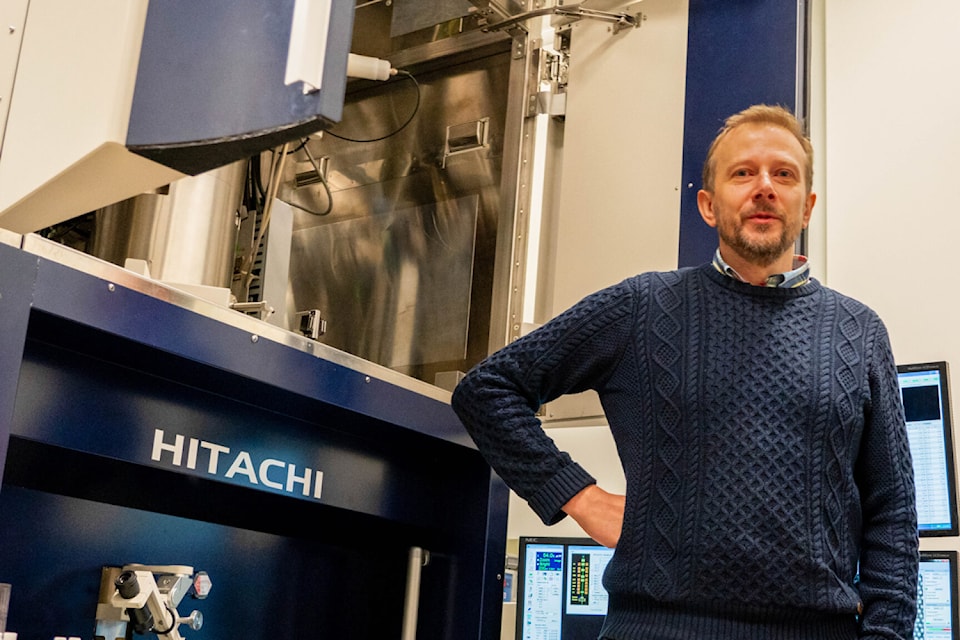Science
Researchers at UVic Revolutionize Microscopy with New Technique

A team of researchers at the University of Victoria has achieved a significant breakthrough in the field of electron microscopy, enabling scientists to visualize atomic-scale structures using more affordable and energy-efficient equipment. Under the leadership of Arthur Blackburn, co-director of UVic’s Advanced Microscopy Facility, this innovation promises to transform microscopy techniques worldwide.
The research, published in Nature Communications, introduces a novel imaging method that allows for sub-Ångström resolution—less than one ten-billionth of a meter—using a compact, low-energy scanning electron microscope (SEM). Previously, such high-resolution imaging was only feasible with large, expensive transmission electron microscopes (TEMs).
“This work shows that high-resolution imaging doesn’t have to rely on expensive, complex equipment,” Blackburn stated. As the Hitachi High-Tech Canada Research Chair in Advanced Electron Microscopy, he emphasized the potential of simpler SEMs when paired with advanced computational techniques. The new approach can achieve resolutions that rival or even surpass traditional methods, making cutting-edge microscopy more accessible to laboratories globally.
The breakthrough utilizes overlapping patterns of scattered electrons to create highly detailed images of samples. This technique enabled the team to achieve a resolution of just 0.67 Ångström, smaller than the size of an atom and approximately one-tenth the width of a human hair.
Implications for Multiple Scientific Fields
The implications of this advancement extend across various scientific disciplines. Blackburn highlighted that this technology could be transformative for fields such as materials science, nanotechnology, and structural biology. “The advance will most immediately benefit the research and production of 2D materials, which are promising in the development of next-generation electronics,” he explained.
In the long term, this technique could also assist in determining the structures of small proteins, offering new avenues for research in health and disease. The accessibility of high-resolution imaging could lead to breakthroughs that enhance our understanding of biological processes and material properties.
As researchers around the world begin to explore the capabilities of this new imaging technique, the potential for innovation and discovery is vast. This achievement not only marks a pivotal moment for the University of Victoria but also sets a new standard for electron microscopy, paving the way for more inclusive scientific exploration.
-

 Science3 months ago
Science3 months agoToyoake City Proposes Daily Two-Hour Smartphone Use Limit
-

 Top Stories3 months ago
Top Stories3 months agoPedestrian Fatally Injured in Esquimalt Collision on August 14
-

 Health3 months ago
Health3 months agoB.C. Review Reveals Urgent Need for Rare-Disease Drug Reforms
-

 Technology3 months ago
Technology3 months agoDark Adventure Game “Bye Sweet Carole” Set for October Release
-

 World3 months ago
World3 months agoJimmy Lai’s Defense Challenges Charges Under National Security Law
-

 Lifestyle3 months ago
Lifestyle3 months agoVictoria’s Pop-Up Shop Shines Light on B.C.’s Wolf Cull
-

 Technology3 months ago
Technology3 months agoKonami Revives Iconic Metal Gear Solid Delta Ahead of Release
-

 Technology3 months ago
Technology3 months agoApple Expands Self-Service Repair Program to Canada
-

 Technology3 months ago
Technology3 months agoSnapmaker U1 Color 3D Printer Redefines Speed and Sustainability
-

 Technology3 months ago
Technology3 months agoAION Folding Knife: Redefining EDC Design with Premium Materials
-

 Business3 months ago
Business3 months agoGordon Murray Automotive Unveils S1 LM and Le Mans GTR at Monterey
-

 Technology3 months ago
Technology3 months agoSolve Today’s Wordle Challenge: Hints and Answer for August 19









